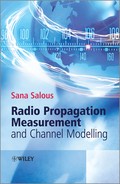Preface
Radio propagation measurements and channel modelling continue to be of fundamental importance to radio system design. As new technology enables dynamic spectrum access and higher data rates, radio propagation effects such as shadowing, the presence of multipath and frequency dispersion are the limiting factors in the design of wireless communication systems. While there are several books covering the topic of radio propagation in various frequency bands, there appears to be no books on radio propagation measurements, which this book addresses at length. To provide the reader with a comprehensive and self-contained book, some background material is provided in the first two chapters, which cover the fundamentals of radio transmission including propagation in ionized media. The aim here is to bring two different communities together, namely those working on communication via the ionosphere in the high frequency (HF) band with those working at ultra-high frequency (UHF) through examples that illustrate that although the medium of transmission is different the principles are similar. Thus the two-ray model commonly used in mobile radio propagation studies is shown to be applicable to the two magneto-ionic waves that propagate via the ionosphere. The distortion effects on wideband signals as they travel through a frequency dispersive medium is studied for both narrow pulses and for frequency modulated continuous wave signals to illustrate the principles of transmission. Some basic path loss models are briefly described at the end of Chapter 2 including a discussion on shadow fading and location variability. Chapter 3 addresses various stochastic channel models and relates them to system models starting from single input–single output to multiple input–multiple output models. Chapter 4 explains at length the principles of design of a radio channel sounder and relates them to radar principles. The different waveforms and architectures are contrasted and calibration techniques and performance measures are detailed to aid the practising engineer in the design and realization of appropriate radio measurement systems. Chapter 5 addresses the important topic of data analysis starting from the most basic discrete Fourier transform to more advanced parametric estimation methods. Multiple antenna processing techniques to extract angle of arrival information including suitable antenna arrays and array calibration as well as multiple antenna channel capacity are detailed. Chapter 6 discusses the prediction of link performance of digital communication systems starting from the basic principles of the matched filter and correlation detector. This is followed by a description of various channel simulators and application of extracted channel parameters to the simulation of link performance of two wireless standards, namely the wireless metropolitan area network and the Wi-Fi standard. Finally, diversity combining methods are briefly outlined.
Throughout the book examples from propagation measurements in the HF band and higher frequency bands have been either specifically reprocessed for presentation or used as appeared in publications. The higher frequency band measurements have been generated by my research students using custom designed radio channel sounders. The wideband HF measurements relate to my earlier work at Birmingham University and here a special gratitude is due to Professor Ramsay Shearman who inspired my interest in radio science and set the direction of my professional career. The move to the UHF band occurred while working with Professor David Parsons at Liverpool University. Working in these two frequency bands enabled me to have a broader outlook on radio propagation. Hence, when multiple antenna technology was being mainly investigated in the UHF band, its application to the HF band seemed a natural extension.
In addition I would like to acknowledge the kind assistance and encouragement of Professor Louis Bertel of Rennes University 1 and Dr Sean Swords of Trinity College Dublin who provided me with their laboratory facilities. Finally, I would like to thank my colleague and friend, Dr Robert Bultitude from the Communications Research Centre, Ottawa, for his contribution to the original outline of the book.
Sana Salous
